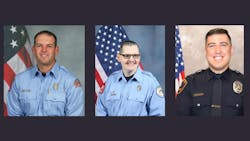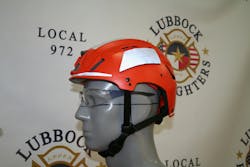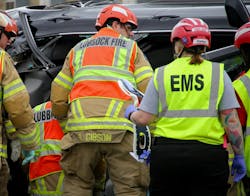Lubbock, TX, Firefighter's Mission for Roadway Safety Helmets after LODDs Moves Forward
More than four years after two firefighters and a police officer died after being struck on a Lubbock, TX, highway, ASTM International (formerly the American Society for Testing and Materials) passed a standard to develop helmets that can help protect firefighters, EMS, law enforcement and others are operating on roadways.
Lubbock Fire Rescue Lt. Eric Hill and Police Officer Matt Nicholas Reyna were struck by a pickup truck on Jan. 11, 2020 while working a crash scene on Highway 27. Both died at the scene.
Firefighter Matt Dawson was also struck and sustained critical injuries.
“He had broken bones all across his body, a broken clavicle, collapsed lungs, broken leg bones,” Lubbock Lt. Brady Robinette told Firehouse.com “But doctors said the human body can heal those things. What can't heal is the most important organ in the body, the brain.”
After a month in the hospital, including having part of his skull removed, Dawson was transported to a rehab center in Colorado for treatment of a traumatic brain injury. Before they transported him, Robinette said they had to put a helmet on him to protect his head.
“That was kind of like the defining moment. I was like, man, we need to be wearing better helmets on the roadway,” Robinette said of the journey he embarked on to help protect responders on roadways.
Both firefighters were wearing structural helmets. “But about a tenth of a second after they got hit by that big F-250 truck, they didn't have their helmets on anymore,” Robinette recalled. “So the helmet they on provided zero protection for them.”
Tragically, Dawson died on Nov. 23, 2023 from complications from his injuries.
This incident put Robinette on a mission to see what he could do to prevent traumatic brian injuries in the future. The first thing that crossed his mind was the head protection found when he wore helmets while dirt bikes.
“Just for a hobby we wear a substantial helmet. I've hit my head in the trees before and, you know, I got back on my dirt bike and finished the race. And I was just like, why are we (on roadway emergencies) not wearing a better helmet?”
“We should have the most important organ in their body protected. If you really think about any industry or any sport has its own standard,” he said of football, motorcycle, skateboarding and other helmet standards. “What if they didn't have a purpose-built helmet?”
Through all the research he and others did, no standard requires firefighters to wear a helmet on roadways, except a few states where it is required by OSHA, but the standard is rather vague when it comes to when and where it has to be worn, and what type of protection is needed.
“I know I told my wife at least seven times before Jan. 11, 2020, it's not structure fires I'm scared about. It's the roadway.”
Survey provides guidance
Two years ago, he started working with ASTM International (formerly the American Society for Testing and Materials) to develop a standard specifically for responders to wear while working along roadways.
The first step was a survey of roadway responders to see what they needed in the form of head protection.
A webbing suspension system, like construction helmets for top-down impact protection, was among the top requests. They called for good ventilation to keep users cool, especially those working on hot blacktop surfaces for extended periods of time, along with protection from roadway debris.
In July, ASTM E3422: Standard Specification for Protective Helmets Worn by Pedestrian Roadway Workers Will Lead to Better Protection Against Roadway Incident Struck-By Hazards was released by ASTM.
He said was similar to an enhanced version of a rescue-style helmet used for swift-water incidents that many firefighters are accustomed to wearing but designed to handle high velocity impacts.
The standard outlines design and performance specifications, chin strap, field of vision, eye protection and helmet retention requirements, along with testing procedures.
“I'm really excited about…It's a global consensus standard that a group of industry experts got together and set these criteria. The helmet needs to meet the needs of roadway workers,” he said.
Robinette joked that the design is not perfect and because of all the requirements the groups wanted from the helmet standard. “If it was (perfect), it would be so big that we wouldn't be able to wear it…You know the old saying, you can tell many firefighters are in the wrecked vehicle by how many helmets are on top.”
He said the process included plenty of discussions on the pros and cons of design factors and the result was a lot of give and take to get where it is today.
The work continues
“It’s been a lot of work to get to this point, but I think I even have more work ahead of me to actually get this standard in use and get mass adoption across the nation,” he said.
Since the standard was approved, Robinette has been presenting to fire and non-fire organizations and is working to get the ASTM standard adopted by local fire departments and NFPA with their 1550 Standard for Emergency Responder Health and Safety and 1971 Standard on Protective Ensembles for Structural Fire Fighting and Proximity Fire Fighting. That process includes letters of support from the key organizations he’s been working with.
"As I go around the nation talking at conferences, I typically ask who has had a close call (on a roadway), and it's usually about 80 to 90 pecent of the people in the room will say yes."
The only resistance he’s seen so far is related to the potential costs, with very few saying the helmets aren’t necessary.
“Every now and then someone will say, ‘You’re going to die anyways if you get by vehicles, so it doesn't matter what you have on your head,’ My response is ‘Well, why would you wear a structural helmet into a structure fire? Because if the building collapses, you're gonna die anyways.”
He added, “You know, Matt Dawson is living proof that you can live from a traumatic brain injury. He lived for three and a half years…I believe if he would've had an appropriate head protection on, he could've walked away with a severe concussion, and he'd be alive today.”
Robinette is planning to meet with helmet manufacturers inside and outside the fire service to help build the first helmet prototype that meets the ASTM standard.
Some have adopted roadway helmets already
He was happy to see that the work to get the ASTM standard developed pushed some agencies who were already equipping their workers with helmets.
In Lubbock, they city bought 400 helmets for every firefighter to prevent a similar tragedy, similar to the water rescue helmet designed Robinette pointed to earlier. The EMS agency also equipped their members with head protection.
Elsewhere in Texas, Irving and Grand Prairie, where they have implemented blocker programs to protect responders, have also given their members helmets. The Viriginia Department of Transportation and Georgia’s Highway Emergency Response Operators are wearing helmets with four-point chin straps.
“I personally think this will be one of the biggest improvements to safety in the fire service since something like the SCBA,” Robinette said. “Across the nation, I believe as a fire service, we respond to three times as many roadway incidents as we do any kind of structure fire calls.”
“My mission is everybody that works on the roadway, not just fire, but it's law enforcement, EMS, and anybody that wears a high visibility vest, has a helmet to protect their brains."
About the Author
Peter Matthews
Editor-in-Chief/Conference Director
Peter Matthews is the conference director and editor-in-chief of Firehouse. He has worked at Firehouse since 1999, serving in various roles on both Firehouse Magazine and Firehouse.com staffs. He completed an internship with the Rochester, NY, Fire Department and served with fire departments in Rush, NY, and Laurel, MD, and was a lieutenant with the Glenwood Fire Company in Glenwood Landing, NY. Matthews served as photographer for the St. Paul, MN, Fire Department and currently is a photographer for the Fort Worth, TX, Fire Department.




